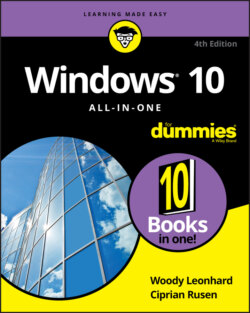Читать книгу Windows 10 All-in-One For Dummies - Ciprian Adrian Rusen, Woody Leonhard - Страница 67
What you lose
ОглавлениеAlthough Microsoft hasn’t talked much about it, the fact is that all the old Windows Live programs are disappearing. Windows Live is, in fact, dead. Windows 8 killed it, and Windows 10 drove a stake through its heart. If you use any of the Windows Live apps in Windows 7 (or Vista or XP, for that matter), your old Live apps are still available, but it doesn’t look like Microsoft is going to do much with them. They certainly aren’t getting any support.
Why? The Windows 10 Universal/Metro apps cover many of the Live bases. Consider these:
Windows Live ID (formerly known as Microsoft Wallet, Microsoft Passport, .NET Passport, and Microsoft Passport Network), which now operates from the Windows Live Account site (confused yet?), is rebranded Microsoft Your Account and referred to informally as your Microsoft Account.
Windows Live OneDrive has already turned into just plain OneDrive. Parts of Ray Ozzie’s Windows Live Mesh — formerly Live Mesh, Windows Live Sync, and Windows Live FolderShare — have been folded into OneDrive, although Microsoft has squashed PC-to-PC sync; the only way to synchronize files is through the OneDrive cloud. It appears as if Mesh has met its match.
Windows Live Mail has officially fallen out of favor, with Microsoft announcing that it won’t support WLM with any Microsoft accounts. Expect Microsoft to push the new Universal Windows Mail as a core Windows communications app. Ditto for Windows Live Calendar.
Windows Live Contacts is now the Windows 10 People app.
Windows Live Photo Gallery morphed into the Windows 10 Photos app.
Windows Live Messenger is dead. It’s been replaced by Skype — or Facebook, or any of a zillion competitors. I use Line, but that’s a story for Book 5, Chapter 2.
It’s not just the Windows Live apps that are dying. Some of the old Windows programs — Media Center being a good example — are just dead. Homegroups got canned, with Microsoft hoping you’ll use OneDrive instead. The old Windows 7 Backup is still there, buried under layers of clicks, but Microsoft would clearly prefer if you didn’t bother with old-fashioned backup and used OneDrive instead.
Some people feel that losing Adobe Reader (and other browser add-ins) in Microsoft Edge is a bad thing. I disagree strongly. Reader (and Flash, which is insulated in Microsoft Edge) have brought on more pain and misery — and hijacked systems — than they’re worth. Microsoft’s own ActiveX technology, which won’t run on Edge, is another malware magnet that deserves to die, as do browser helper objects, home page hijackers, custom toolbars, and much more. You can run all those add-ins in the Legacy desktop version of Internet Explorer if you absolutely must.
Some other odd missing pieces include the following:
ClearType doesn’t run on the Windows 10 apps’ interface, at all. It’s still on the old-fashioned desktop, but your Windows 10/Universal/Metro apps can’t use it. Note that this is different from Microsoft’s ClearType HD technology, a marketing term for the monitors on Microsoft Surface tablets. I have no idea why Microsoft used the same term for both.
Flip 3D is gone. Little more than a parlor trick, and rarely used, the Windows key+Tab used to show a 3D rendering of all running programs and flip among them. Stick a fork in it. Now it cycles among desktops.
